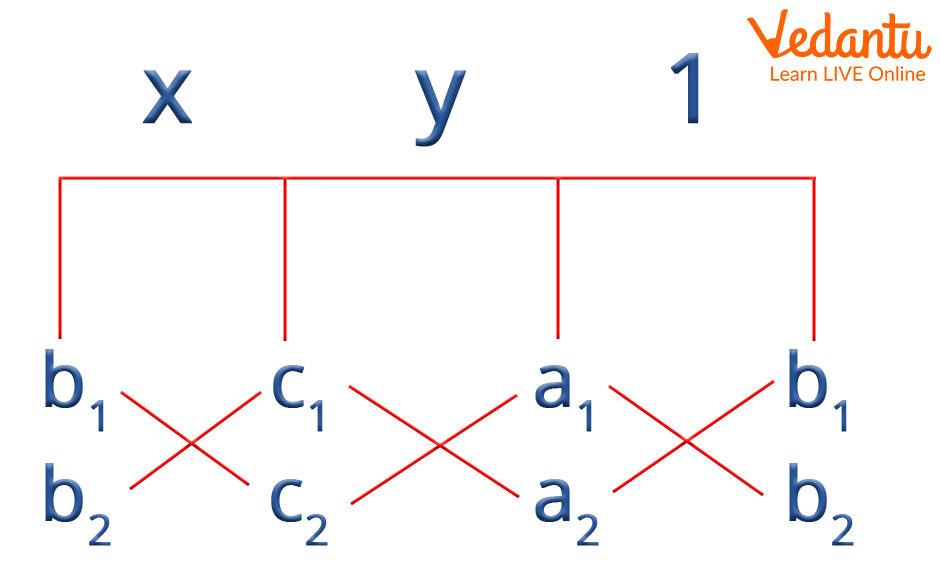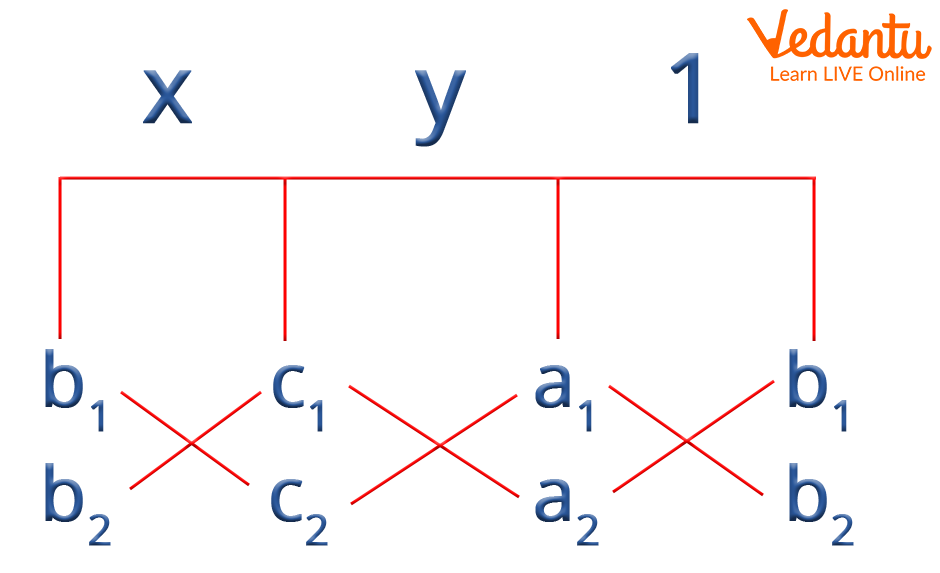




How to Apply Cross Multiplication in Math Problems
Cross Multiplication is generally used for calculations of fractions for equating unequal denominators and simplifying them and solving the required operations. Using the same steps, a cross multiplication formula was derived which can be used to solve the linear equations in two variables easily and efficiently.
What is an Equation?
We all are very familiar with the term equations, which in general refers to two math based expressions which are connected by an equal sign.

Example of an Equation
Here, in the above image the expression \[5{\rm{y}} - 4 = 13\]
, 5 is the coefficient of the variable y and 4 is the constant.
Constant : In simple words, the numerical value which does not change or in simple terms, it does not have an alphabet i.e. variable with it is termed as a constant.
Variable : The term whose value varies and may be not known and is generally denoted by the english alphabet is a variable.
Coefficient : The number which is accompanied by a variable is termed as the coefficient of that variable. If there is no coefficient to the variable it is considered to be one.
What is a Linear Equation?
As we all are well versed with the terms constant and variables, the equation in which the highest power of the variable is 1 is termed as a linear equation.
What is a Linear Equation in Two Variables ?
A linear equation which has two variables whose highest power is 1 is said to be a linear equation in two variables.

Example of a Linear Equation in Two Variables
Methods for Solving Simultaneous Linear Equations :
Generally, there are three methods for solving two simultaneous linear equations - Substitution method, Elimination method and Cross- Multiplication method.
What is the Cross Multiplication Method ?
Cross multiplication method is the easiest method of solving simultaneous linear equations and it can be used only when there are two linear equations in two variables. In cross multiplication, we generally multiply the numerator of the first fraction with the denominator of the second and numerator of second with the denominator of first. Here, to understand the formula we use the following two equations :
\[{{\rm{a}}_{\rm{1}}}{\rm{x}} + {{\rm{b}}_{\rm{1}}}{\rm{y}} + {{\rm{c}}_1} = 0\]
\[{{\rm{a}}_{\rm{2}}}{\rm{x}} + {{\rm{b}}_{\rm{2}}}{\rm{y}} + {{\rm{c}}_2} = 0\]
Here, we can see that \[{{\rm{a}}_{\rm{1}}}\] and \[{{\rm{a}}_{\rm{2}}}\] are the coefficients of x ; \[{{\rm{b}}_{\rm{1}}}\]and \[{{\rm{b}}_{\rm{2}}}\] are the coefficients of y and \[{{\rm{c}}_{\rm{1}}}\] and \[{{\rm{c}}_{\rm{2}}}\]are the constants.
So, we can find the values of x and y by cross multiplication formula by using the steps given in the following image :

Cross-Multiplication formula
From the above image, we get the relation :
\[\frac{{\rm{x}}}{{{{\rm{b}}_{\rm{1}}}{{\rm{c}}_{\rm{2}}} - {{\rm{b}}_{\rm{2}}}{{\rm{c}}_{\rm{1}}}}} = \frac{{\rm{y}}}{{{{\rm{c}}_{\rm{1}}}{{\rm{a}}_{\rm{2}}} - {{\rm{c}}_{\rm{2}}}{{\rm{a}}_1}}} = \frac{1}{{{{\rm{a}}_{\rm{1}}}{{\rm{b}}_{\rm{2}}} - {{\rm{a}}_{\rm{2}}}{{\rm{b}}_{\rm{1}}}}}\]
On simplifying the the relation we can get the values of x and y
Solved Examples :
Solve the given pair of linear equations using the cross multiplication formula :
\[7{\rm{x}} + 3{\rm{y + 4 = 0}}\]
\[4{\rm{x + y + 2 = 0}}\]
Solution : Here, 7 and 4 are the coefficients of x ; 3 and 1 are the coefficients of y and 4 and 2 are the constants.
Now, using the cross multiplication formula we have :

Cross Multiplication Formula
\[\frac{{\rm{x}}}{{{{\rm{b}}_{\rm{1}}}{{\rm{c}}_{\rm{2}}} - {{\rm{b}}_{\rm{2}}}{{\rm{c}}_{\rm{1}}}}} = \frac{{\rm{y}}}{{{{\rm{c}}_{\rm{1}}}{{\rm{a}}_{\rm{2}}} - {{\rm{c}}_{\rm{2}}}{{\rm{a}}_1}}} = \frac{1}{{{{\rm{a}}_{\rm{1}}}{{\rm{b}}_{\rm{2}}} - {{\rm{a}}_{\rm{2}}}{{\rm{b}}_{\rm{1}}}}}\]
Using the above result , we have :
\[\frac{{\rm{x}}}{{3 \times 2 - 1 \times 4}} = \frac{{\rm{y}}}{{4 \times 4 - 2 \times 7}} = \frac{1}{{7 \times 1 - 4 \times 3}}\]
\[\frac{{\rm{x}}}{{6 - 4}} = \frac{{\rm{y}}}{{16 - 14}} = \frac{1}{{7 - 12}}\]
\[\frac{{\rm{x}}}{2} = \frac{{\rm{y}}}{2} = \frac{1}{{ - 5}}\]
On equating x with the constant term,
\[x = - \frac{2}{5}\]
On equating y with the constant term,
\[{\rm{y}} = - \frac{2}{5}\]
Solve the given pair of linear equations using the cross multiplication formula :
\[{\rm{x}} + {\rm{y}} - 8 = 0\]
\[5{\rm{x}} + 3{\rm{y}} + 2 = 0\]
Solution : Here, 1 and 5 are the coefficients of x ; 1 and 3 are the coefficients of y and -8 and 2 are the constants. Now, using the cross multiplication formula we have :
\[\frac{{\rm{x}}}{{{{\rm{b}}_{\rm{1}}}{{\rm{c}}_{\rm{2}}} - {{\rm{b}}_{\rm{2}}}{{\rm{c}}_{\rm{1}}}}} = \frac{{\rm{y}}}{{{{\rm{c}}_{\rm{1}}}{{\rm{a}}_{\rm{2}}} - {{\rm{c}}_{\rm{2}}}{{\rm{a}}_1}}} = \frac{1}{{{{\rm{a}}_{\rm{1}}}{{\rm{b}}_{\rm{2}}} - {{\rm{a}}_{\rm{2}}}{{\rm{b}}_{\rm{1}}}}}\]
Using the above result , we have :
\[\frac{{\rm{x}}}{{1 \times 2 - 3 \times [ - 8]}} = \frac{{\rm{y}}}{{[ - 8] \times 5 - 2 \times 1}} = \frac{1}{{1 \times 3 - 5 \times 1}}\]
\[\frac{{\rm{x}}}{{2 - [ - 24]}} = \frac{{\rm{y}}}{{ - 40 - 2}} = \frac{1}{{3 - 5}}\]
\[\frac{{\rm{x}}}{{26}} = \frac{{\rm{y}}}{{ - 42}} = \frac{1}{{ - 2}}\]
On equating x with the constant term,
\[x = - \frac{{26}}{2} = - 13\]
On equating y with the constant term,
\[{\rm{y}} = \frac{{ - 42}}{{ - 2}} = 21\]
Solve the given pair of linear equations using the cross multiplication formula :
\[4{\rm{x}} + 2{\rm{y}} + 3 = 0\]
\[3{\rm{x}} - 7{\rm{y}} - 2 = 0\]
Solution : Here, 4 and 3 are the coefficients of x ; 2 and -7 are the coefficients of y and 3 and -2 are the constants.
Now, using the cross multiplication formula we have :
\[\frac{{\rm{x}}}{{{{\rm{b}}_{\rm{1}}}{{\rm{c}}_{\rm{2}}} - {{\rm{b}}_{\rm{2}}}{{\rm{c}}_{\rm{1}}}}} = \frac{{\rm{y}}}{{{{\rm{c}}_{\rm{1}}}{{\rm{a}}_{\rm{2}}} - {{\rm{c}}_{\rm{2}}}{{\rm{a}}_1}}} = \frac{1}{{{{\rm{a}}_{\rm{1}}}{{\rm{b}}_{\rm{2}}} - {{\rm{a}}_{\rm{2}}}{{\rm{b}}_{\rm{1}}}}}\]
Using the above result , we have :
\[\frac{{\rm{x}}}{{2 \times [ - 2] - [ - 7] \times 3}} = \frac{{\rm{y}}}{{3 \times 3 - [ - 2] \times 4}} = \frac{1}{{4 \times [ - 7] - 3 \times 2}}\]
\[\frac{{\rm{x}}}{{ - 4 - [ - 21]}} = \frac{{\rm{y}}}{{9 - [ - 8]}} = \frac{1}{{ - 28 - 6}}\]
\[\frac{{\rm{x}}}{{17}} = \frac{{\rm{y}}}{{17}} = \frac{1}{{34}}\]
On equating x with the constant term,
\[{\rm{x}} = \frac{{17}}{{34}} = \frac{1}{2}\]
On equating y with the constant term,
\[{\rm{y}} = \frac{{17}}{{34}} = \frac{1}{2}\]
Conclusion:
Cross multiplication method is one of the three methods for solving pairs of linear equations in two variables and is the easiest one among them. In this we generally cross multiply the terms of the two equations and the formed result is generally used as a formula to solve the sums easily and efficiently. After substituting the values as per the question in the formula, we equate it to the constant term to find the values of x and y respectively.
FAQs on Cross Multiplication Formula Explained
1. What is the method of cross-multiplication in the context of linear equations?
The method of cross-multiplication is an algebraic technique used to find the unique solution for a pair of linear equations in two variables. For a system of equations in the standard form, a₁x + b₁y + c₁ = 0 and a₂x + b₂y + c₂ = 0, this method provides a direct formula to calculate the values of x and y without using substitution or elimination.
2. Can you explain how the cross-multiplication formula is derived?
The formula is derived from the method of elimination. By multiplying the first equation by b₂ and the second by b₁, we can eliminate the 'y' variable to find 'x'. Similarly, multiplying the equations by a₂ and a₁ respectively allows us to eliminate 'x' and find 'y'. This process of elimination and rearrangement leads to the standard cross-multiplication formula: x/(b₁c₂ - b₂c₁) = y/(c₁a₂ - c₂a₁) = 1/(a₁b₂ - a₂b₁). It is essentially a shortcut for the elimination method.
3. How can you solve a pair of linear equations using the cross-multiplication method with an example?
Let's solve the equations 2x + y – 5 = 0 and 3x + 2y – 8 = 0. Here, a₁=2, b₁=1, c₁=-5 and a₂=3, b₂=2, c₂=-8. Using the formula:
- x / [(1)(-8) – (2)(-5)] = x / (-8 + 10) = x / 2
- y / [(-5)(3) – (-8)(2)] = y / (-15 + 16) = y / 1
- 1 / [(2)(2) – (3)(1)] = 1 / (4 – 3) = 1 / 1
Now, by equating x/2 = 1 and y/1 = 1, we find the solution: x = 2 and y = 1.
4. What is a simple trick to remember the cross-multiplication formula arrangement?
A simple way to remember the formula is to use a diagram. Write the variables x, y, and 1. Below them, write the coefficients starting from 'b', moving to 'c', then 'a', and back to 'b':
x y 1
b₁ c₁ a₁ b₁
b₂ c₂ a₂ b₂
To find the term under x, you cross-multiply the 'b' and 'c' columns: b₁c₂ – b₂c₁. For y, cross-multiply 'c' and 'a': c₁a₂ – c₂a₁. For 1, cross-multiply 'a' and 'b': a₁b₂ – a₂b₁. This visual aid helps prevent errors.
5. When is it better to use the cross-multiplication method over substitution or elimination?
The cross-multiplication method is particularly useful when the coefficients (a₁, b₁, c₁, etc.) are large numbers, fractions, or decimals. In such cases, methods like substitution or elimination can involve complex calculations and a higher risk of error. Cross-multiplication provides a direct, formula-based approach that can be more efficient and systematic, reducing the number of intermediate calculation steps.
6. How does the cross-multiplication method indicate if a system has no solution or infinite solutions?
This is determined by the denominator of the formula, (a₁b₂ – a₂b₁). According to the CBSE syllabus for the 2025-26 session:
- Unique Solution: If a₁b₂ – a₂b₁ ≠ 0, the equations have a unique solution.
- No Solution or Infinite Solutions: If a₁b₂ – a₂b₁ = 0, the lines are either parallel (no solution) or coincident (infinite solutions). You must then check the ratios. If a₁/a₂ = b₁/b₂ = c₁/c₂, the solutions are infinite. If a₁/a₂ = b₁/b₂ ≠ c₁/c₂, there is no solution.
7. What is the most common mistake made while applying the cross-multiplication method?
The most frequent mistake is failing to write the equations in the standard form ax + by + c = 0. Students often leave the constant term on the right side of the equation (e.g., ax + by = k), which results in an incorrect sign for 'c' when applying the formula. Another common error is mixing up the subtraction order in the formula, like calculating b₂c₁ - b₁c₂ instead of b₁c₂ - b₂c₁, leading to an incorrect result.
8. Can we use the cross-multiplication method if a constant term is zero?
Yes, absolutely. If a constant term, for instance c₁, is zero, the equation is of the form a₁x + b₁y = 0. The method still applies perfectly. You simply substitute c₁ = 0 into the formula. This often makes the calculation simpler. For example, the term under x becomes (b₁c₂ - b₂*0), which simplifies to b₁c₂. The formula remains robust even in such cases.





















